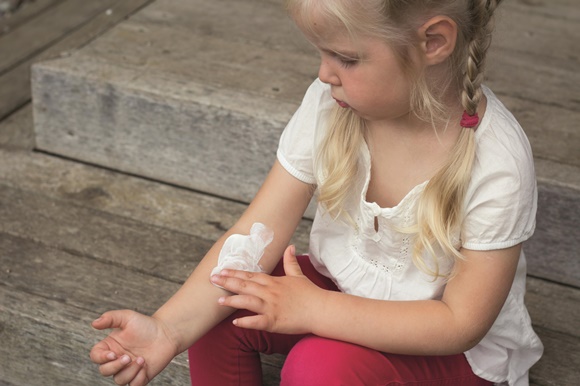It’s An Itchy World Out There!
September 4, 2020

Eczema, also known as Atopic Dermatitis, is a common skin condition characterized by red, dry, itchy patches on the skin. Eczema is caused by problems with the skin barrier that make it difficult for the skin to hold in moisture and keep out bacteria and irritants. It is common in children and may present differently in each child. It may be in small patches or widespread on the body.
- In babies: Usually starts on scalp and face. Red, dry rashes may appear on cheeks, forehead, and around mouth. Usually not seen in diaper area
- In young children: Often seen in the elbow creases, backs of knees, neck, and around eyes.
Eczema usually runs in families and tends to occur with other conditions such as asthma and environmental allergies.
You can help treat and control your child’s eczema or dry skin by making a few adjustments to products and routines used in your home. Making the change to sensitive or free/clear products decreases exposure to irritants, perfumes, and dyes that may cause eczema flare ups. Some allergy and dermatology recommended options include:
- Soap/body wash:
- Dove Sensitive (bar or body wash)
- Aveeno Eczema Therapy Wash
- CeraVe Cleanser
- Cetaphil Gentle Skin Cleanser or Bar (Not face wash)
- Vanicream Cleansing Bar
- Laundry detergent:
- Tide Free
- All Free & Clear
- Cheer Free
- Purex Free
- Fabric Softener
- Bounce Free
- Downy Free & Clear
- Moisturizer:
- Aquaphor Ointment (contains lanolin)
- Vaseline Ointment (Fragrance free)
- Vanicream
- Cetaphil Cream (contains almond oil)
- CeraVe Cream
- Aveeno Eczema Therapy (Moisturizing cream or nighttime balm)
- Eucerin Cream (contains lanolin)
- Sunblock:
- Vanicream Sensitive Skin (SPF 30 or 60)
- Neutrogena Sensitive Skin (SPF 60+)
- Neutrogena Pure & Free Baby (SPF 60+)
- Aveeno Natural Protection (SPF 30)
Dryness (Repairing the Skin Barrier)
- Give your child a bath or shower every day for 5-10 minutes in lukewarm water. Use fragrance free hypoallergenic wash and avoid scrubbing skin with anything rough. Do not use bubble bath.
- Pat skin dry. Apply any prescribed topical medications prior to moisturizers. (It is best to moisturize immediately after removing your child from the tub while the skin is still damp to lock in moisture)
- Apply moisturizer every day, even when the rash is gone
- Dress child in soft fabrics & use mild fragrance free detergents
Reducing the Itch
- Prevent scratching. This can lead to more itching and to open sores that increase risk of infection.
- Ask your pediatrician if your child would benefit from daily antihistamines (allergy medications) as some children have eczema flare ups related to exposure to a potential allergen
- If you feel that over the counter remedies are not providing relief for your child, contact your pediatrician to determine if your child is a candidate for other prescription medications.
Remember that eczema is not contagious, however, the broken skin caused by scratching may become infected with normal bacteria on the skin or under the nails. Talk to your child’s doctor if you see yellow or honey-colored crusting and scabbing, weeping or oozing skin, blisters or pus bumps, or a rash that is not getting better even with the usual treatments.
Next Post >>